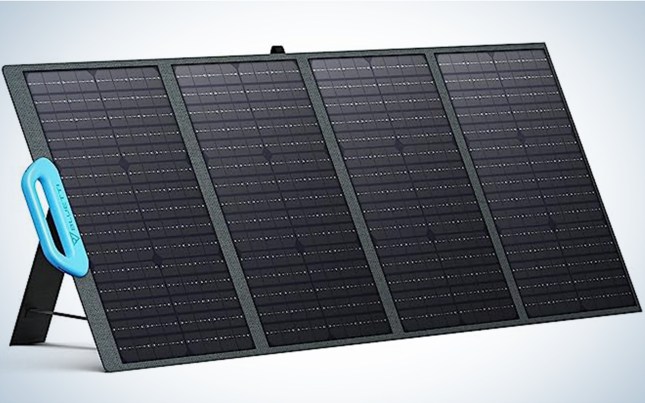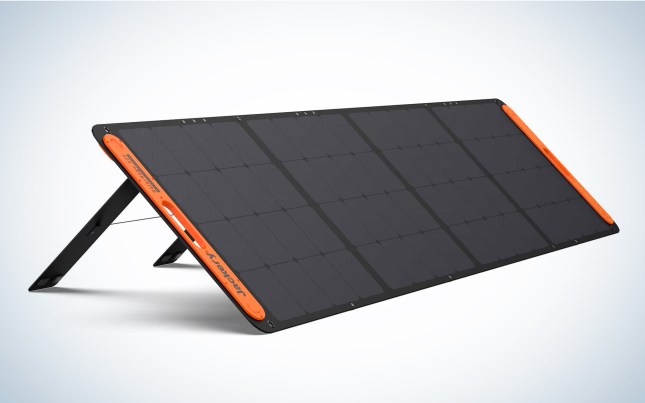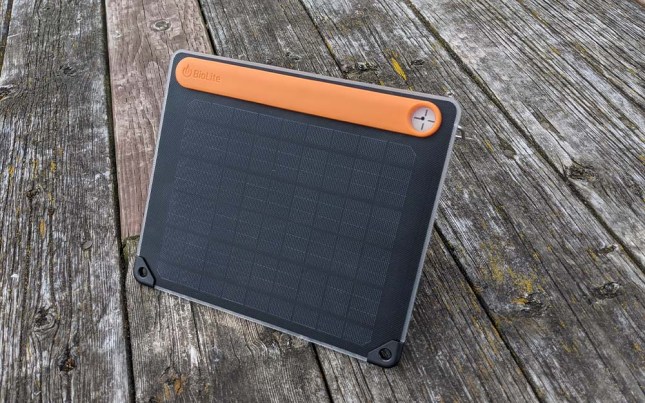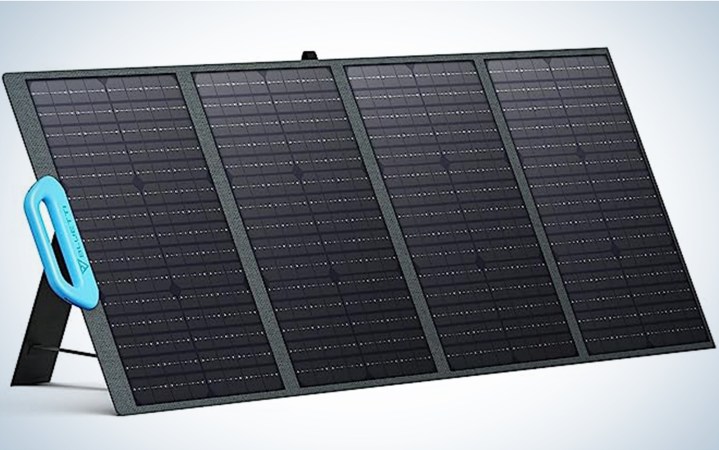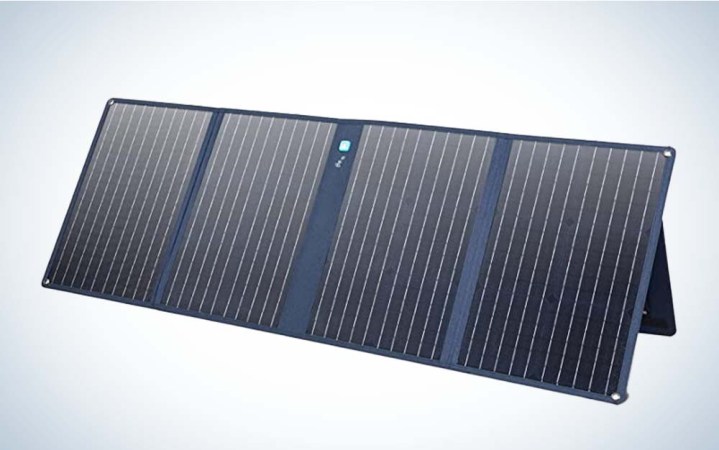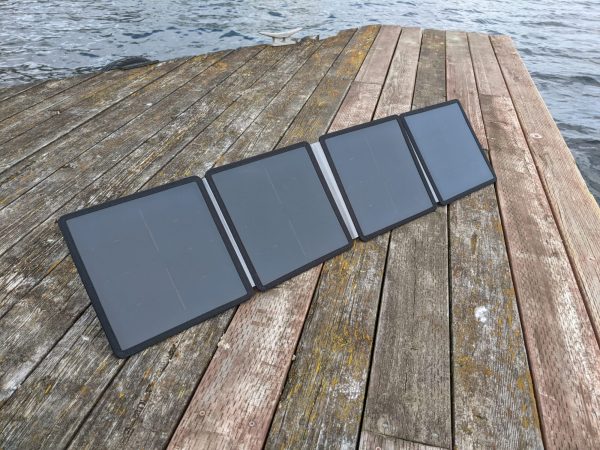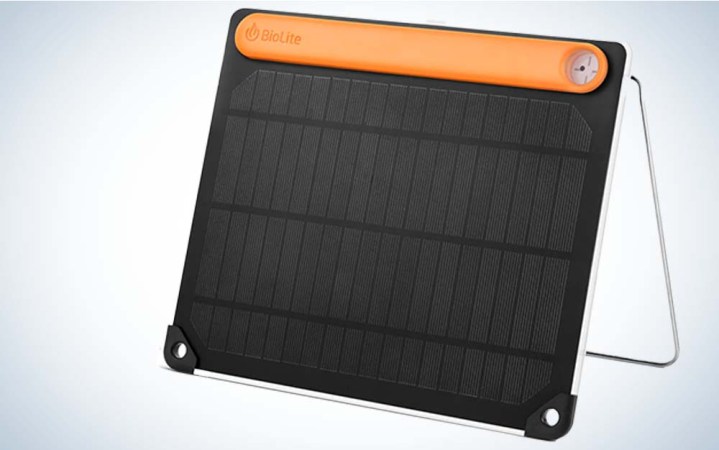We may earn revenue from the products available on this page and participate in affiliate programs. Learn More ›
Experienced campers know that you can get off the grid without having to ditch your electronics if you bring along a great solar panel that’s built for camping and outdoor environments. Modern panels have come a long way since the low amperage models of even a few years ago and with the right setup, you can power anything from a laptop to an electric cooler, with nothing more than a clear view of the sky on a sunny day (sometimes you don’t even need that). To find the best solar panels for camping, I put high-performing models from the top brands to the test:
- Best Overall: Bluetti PV120 Solar Panel
- Best for Overlanding: Jackery SolarSaga 200
- Honorable Mention: Anker 625 Solar Panel
- Best for Tight Spaces: Lion 50W Foldable
- Best Built-In Battery: BioLite SolarPanel 5+
How I Tested the Best Solar Panels for Camping
My initial test of solar panels for camping on a classic Pacific Northwest “Juneary” day. It should have been summer already, but it just wasn’t and wouldn’t be for a while. Solar panels were then evaluated on a number of criteria, including:
- Power Output: I tested each panel to see how long it took to charge my phone 5 percent. The larger panels were also tested on how long it took to charge a 32,000 mAh battery pack 5 percent, and whether the panel could charge both my phone and the battery pack at the same time. The battery pack used during this portion of the test was not the same brand as any of the products tested.
- Size: The size of the products I tested ranged from small panels that could crossover to backpacking all the way out to foldable four-panels arrays that can be chained together.
- Features: I considered the features of each solar panel in my test and the potential they had to improve the overall experience of the unit.
- Ease of Use: I considered how easy it was to set up and position each solar panel and how easy it was to break them down again for storage.
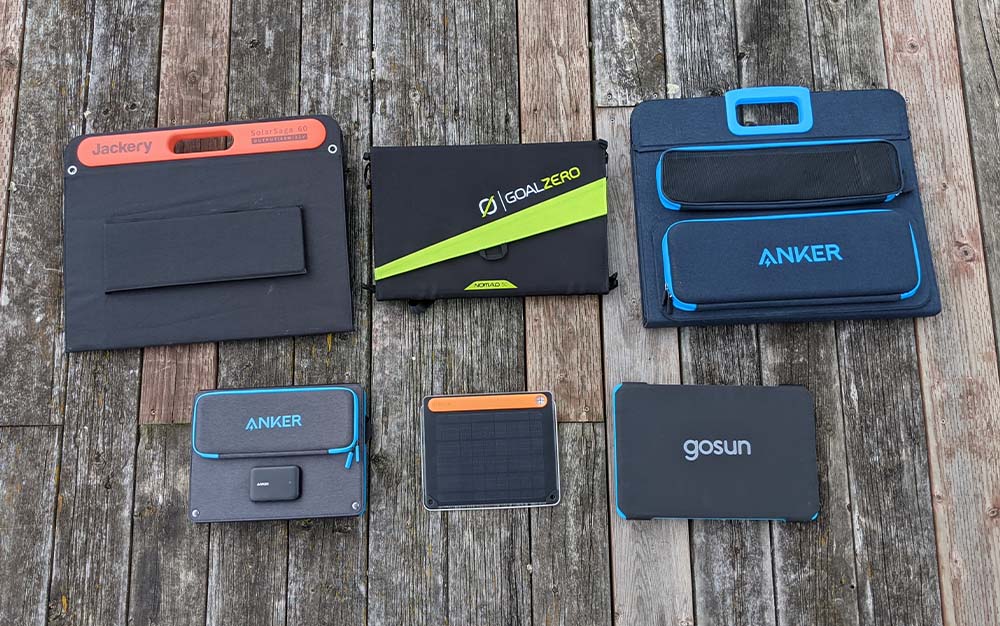
I’ve been continuing to test solar panels, large and small, since then, including in our roundup of the best solar generators and the best solar chargers.
The Best Solar Panels for Camping: Reviews and Recommendations
Best Overall: Bluetti PV120 Solar Panel
Key Features
- Max output: 120 watts
- Weight: 12.6 pounds
- Ports: MC4 connector (with DC adaptor)
- Dimensions: 65 inches x 21 inches x 1.8 inches (unfolded); 18.5 inches x 21 inches x 3.4 inches (folded)
- Warranty: 12 months
Pros
- Compact package
- Generates over 100 watts of power under clear skies
- Snap features make setup and takedown a breeze
Cons
- No sun dial feature
- Cannot plug directly into a smartphone
The Bluetti PV120 Solar Panel is one of the best solar panels I’ve tested, and just barely squeaked out the Anker 625 for the top slot. These two panels, similarly sized and priced (with the Bluetti typically running a bit less expensive), were tested side by side under sunny skies. The Bluetti produced 16 more watts during testing, an over 15 percent difference in performance. I also appreciated that its kickstands had snap buttons at the adjustment points, making it simpler to find the correct angle then on solar panels that lacked that feature.
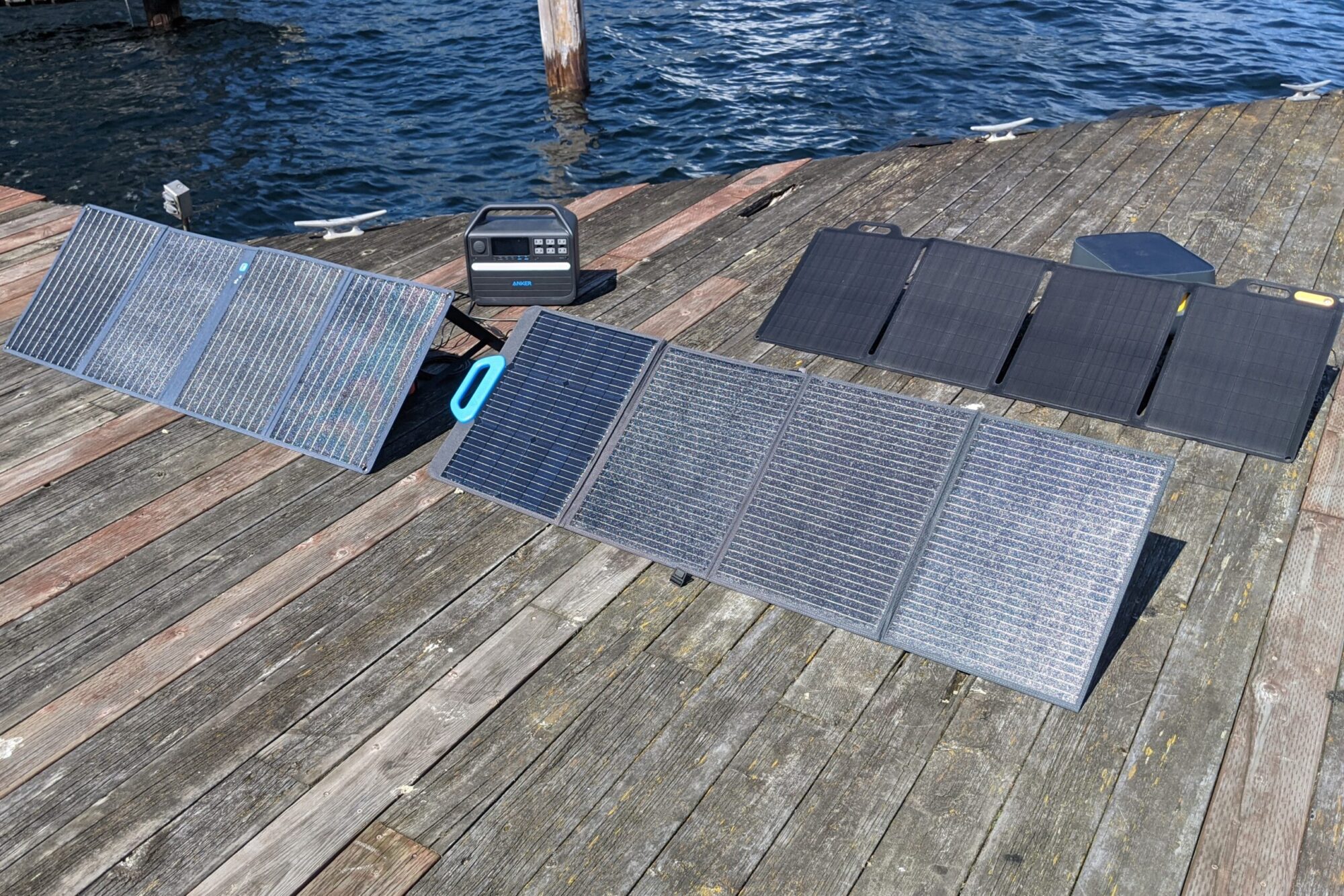
Even storage was simpler, thanks to snaps that wrap around the accordian sides to hold the package together when folded up, eliminating the need for an extra carrying case. This has become my new go-to panel when I head out camping due to its space savings and power generation potential. Even better, since its DC-compatible cable pairs with the Goal Zero Yeti and Jackery power stations, I’m able to use it with my favorite power station for camping.
Best for Overlanding: SolarSaga 200W Solar Panel
Key Features
- DC port: 200W (18V)
- Weight: 18 pounds
- Ports: DC only
- Dimensions: 21.2 x 91.3 x 1 inches (unfolded); 21.2 x 24.2 x 1.6 inches (folded)
- Warranty: 3 years
Pros
- Easy to use
- Powerful panel that draws power in every light condition
Cons
- Expensive
- No USB port
The Jackery SolarSaga 200W has consistently impressed me for its ease of use and reliable power generation. When I initially tested this panel, as part of my test of the best solar generators, it registered 184 watts of energy coming from a single panel. At other times it’s exceeded it’s claimed 200 watt output. Even in the shade, it’s impressive, pumping out more power than comparable size panels. I’ve even seen it produce a charge (6 watts) in total shade at dusk.
Each panel comes with a carrying case and a cable that tucks inside of a zipped pocket. The panel accordions up on itself nicely, such that if you could find different storage for the power cord, you could potentially leave the carrying case at home. Something I like about the charging cord for this panel is that it is designed for different voltage requirements on different Jackery power stations. That gives you a lot of flexibility for pairing it with other (potentially non-Jackery) power stations that are already in your arsenal.
Honorable Mention: Anker 625 Solar Panel
Key Features
- USB max output: 15W (5V)
- XT-60 port: 100W (26.5V)
- Weight: 11 pounds
- Ports: USB-A, USB-C, and XT-60 (includes both XT-60 to XT-60 cord and XT-60 to DC7909 connector)
- Dimensions: 56.9 inches x 20.7 inches x 1.8 inches (unfolded); 20.7 inches x 18.5 inches x 3.4 inches (folded)
- Warranty: 18 months
Pros
- Strongest panel in my test, charged two devices simultaneously under very overcast skies
- Overpower protection
- Integrated sundial
Cons
- Expensive
- Less stable when set up than other panels in my test
Despite being dethroned from the top slot, the Anker 625 is still one of the best solar panels out there, and an excellent addition to any camping setup. During the cloudiest part of my initial testing day, when dark gray clouds obscured the sun and the other solar panels packed it in, the Anker 625 was still able to charge my phone 5 percent in only five minutes. Then it powered up a 32,000 mAh battery pack 5 percent in a half hour under similar conditions. When I plugged both the battery pack and the phone in at the same time, it kept charging. If there is any chance of less-than-ideal weather on your camping trip, then this is the solar panel solution you’ve been looking for.
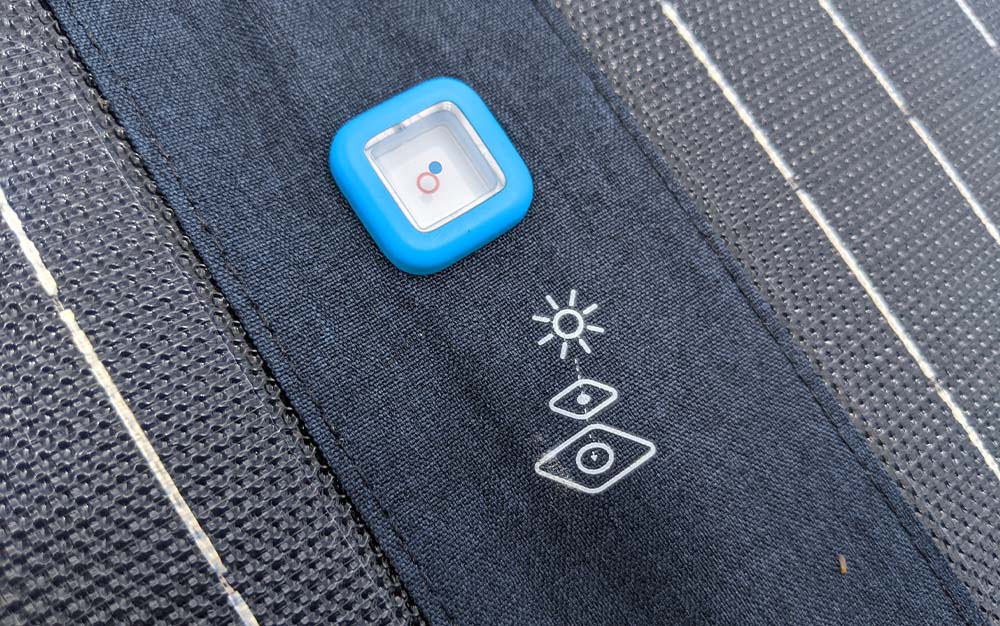
The Anker 625 was also only one of two solar panels in my test to incorporate an integrated sundial, which allowed me to optimize the positioning of the panel. This is helpful when it’s tough to distinguish the angle of the sun. Less helpful were the kickstands. Despite the nearly five-foot width of the four panels, there were only two kickstands provided, one on each end. This meant that the unit had a tendency to sag in the middle, and it moved more in the light breeze that blew during testing than other setups with a higher kickstand to panel ratio.
Best for Tight Spaces: Lion 50W Foldable
Key Features
- USB max output: 27W (12V)
- DC port: 48W (18V)
- Weight: 3 pounds
- Ports: USB-A, USB-C, and DC
- Dimensions: 46 inches x 11.3 inches x 0.8 inch (unfolded); 11.3 inches x 11.3 inches x 1.6 inches (folded)
- Warranty: 1 year
Pros
- Compact
- More powerful than it looks
- Lightweight
Cons
- Less powerful than larger 100W models
I’ll admit I had low expectations for the Lion 50W Foldable when I first took it out of the box. It’s noticeably smaller than other 50W panels I’ve tested—would it really be able to match its power specs? The setup is also pretty flimsy, with only two small kickstands stitched onto the back panel fabric.
But then I set up the panel, on a cloudy and windy March day, and was more than impressed. In medium light (where the sun isn’t exactly visible, but there is plenty of active light coming through the clouds), the panel kicked out enough juice from the USB-C port to charge my laptop. Not bad for three pounds.
While this is just too large and too heavy to consider for a backpacking trip, its combination of small size and power make it practically a necessity for a pack rafting or canoe trip. (Just make sure you pair it with one of the best dry bags.)
Best Built-In Battery: BioLite SolarPanel 5+
Key Features
- Max power output: 5W
- Weight: 13.8 ounces
- Ports: USB-A
- Dimensions: 10.1 inches x 8.2 inches x 1 inch
- Also available in SolarPanel 10+
- Warranty: 1 year
Pros
- 3200mAh internal battery
- Affordable
- Small and lightweight
- Integrated sundial and adjustable kickstand
Cons
- Slowest charging time of the solar panels I tested
- Performs poorly in even slightly cloudy weather
Not everyone is looking to charge an electric cooler or laptop while camping. Sometimes, you just want to juice up your phone a bit, so that you don’t have to monitor how much battery is left over the course of your trip.
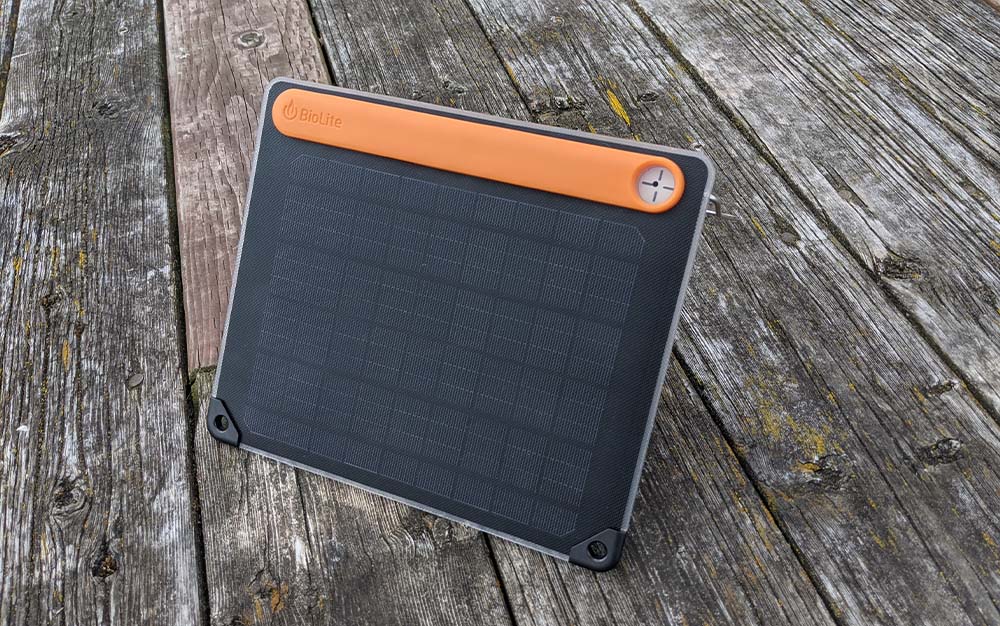
The BioLite Solar Panel 5+ is essentially a low-cost alternative to a smaller battery pack. Its max output is only 5 watts, which, while too low to charge a larger battery pack, is ideal for charging a smartphone. I also liked that it featured an adjustable kickstand (the only one of the solar panels I tested) and an integrated sundial, which I used to optimize the positioning of the panel during testing. However, it still took the BioLite Solar 5+ 22 minutes to charge my phone 5 percent, even though it was sunnier (although still quite cloudy) than during other parts of my test. Unlike the other other panels, which could be used to spot charge a device on the go, the best and highest use of the BioLite is to charge the onboard 3,200 mAh battery (which can also be charged before leaving home via a micro USB port), speeding up your smartphone recharge so that you can get going again.
Things to Consider Before Buying a Solar Panel for Camping
How Solar Panels Work
At its most basic, solar panels are made up of solar cells that convert sunlight into electricity. Each cell has two conductive layers, in between which are two different types of silicone—one with extra electrons, and one with space for electrons. When sunlight hits a solar panel, it sends a photon slamming into a solar cell, which in turns knocks one of the extra electrons loose. When that electron makes its way over to one of the silicone layers with space for electrons it creates a positive charge on one side and a negative charge on another. The solar cell channels the movement of the electrons, so that it can capture the energy it produces as it moves. While the amount of energy captured by each solar cell is negligible, when strung together in a solar panel, it can be quite impressive, with some of the solar panels in my test able to produce as many as 100W.
Some solar panels are better at regulating this output of energy than others, which matters when you are trying to capture this energy on the other side, whether in a power bank or directly into a device like some of the best solar generators. For instance, if you try to charge your smartphone on a port that can output 20V of power, then there is a good chance that you’ll damage the battery of your phone, even if in the moment it appears that your phone is simply charging extremely quickly. The solar panels in my test limited the voltage output from the USB ports (5V or less), while the DC ports, which are intended to pair with one of the best power banks for camping, provided a higher voltage output (between 14.5V and 26.5V). While this provides some protection against accidentally overcharging your devices, it’s still worth knowing how the max voltage output of each solar panel port compares to what your device’s or power bank’s battery can handle.
Power Output
While there are differences in the power ratings between solar panels, generally speaking, the larger a solar panel is, the more power it will generate. This is why solar panels for camping are typically folded twice or more—to maximize the amount of surface area they can cover when in use, while also minimizing the amount of space they occupy during transit.
Packed Size
While most people have plenty of room to spread out a solar panel unit at camp, the same can not always be said of the vehicle you use to get to get there. If your space is limited, the weather is predictable, and your power needs are low, consider a smaller solar panel.
External Battery
Many of the best solar panels for camping are designed to pair with a power bank for camping. This is because most solar panels do not have a way to store the electricity they generate when the sun is shining for those times when it’s overcast or slightly cloudy. Further, since the USB ports on most solar panels for camping limit the voltage output—to prevent inadvertent damage to the battery of smaller electronics, it’s important to ensure that your solar panel has a port that matches the high voltage output port of your power bank.
Chaining Solar Panels
To maximize the power captured in a battery pack during the sunniest portion of the day, some campers may opt to link, or chain together, multiple solar panels into a single array.
FAQs
Solar panels for camping can cost anywhere from $80 to over $300, depending on the size and quality of the panels.
The size solar panel that is best for camping depends on what you are trying to charge with it. If you are looking to charge a smartphone, then a smaller single panel (with an accompanying battery) is all you’ll need to get going. If you have multiple appliances or devices that you are looking to charge, then a triple or quadruple panel setup (or even an array chained together) will work better.
If you try to charge your smartphone on a port that can output 20V of power, then there is a good chance that you’ll damage the battery of your phone, even if in the moment it appears that your phone is simply charging extremely quickly. The solar panels in my test limited the voltage output from the USB ports (5V or less), while the DC ports, which are intended to pair with a battery pack, provided a higher voltage output (between 14.5V and 26.5V). While this provides some protection against accidentally overcharging your devices, it’s still worth knowing how the max voltage output of each solar panel port compares to what your device’s or power bank’s battery can handle.
Final Thoughts
After testing the best solar panels for camping from Jackery, Anker, Goal Zero, BioLite, and GoSun, the Anker 625 claims the top spot. If you’re only looking to power a smartphone, either the Anker 515 or the BioLite 5+ will provide sufficient juice at a lower cost (and a slower speed).
- Best Overall: Bluetti PV120 Solar Panel
- Best for Overlanding: Jackery SolarSaga 200
- Honorable Mention: Anker 625 Solar Panel
- Best for Small Spaces: Lion 50W Foldable
- Best Built-In Battery: BioLite SolarPanel 5+

